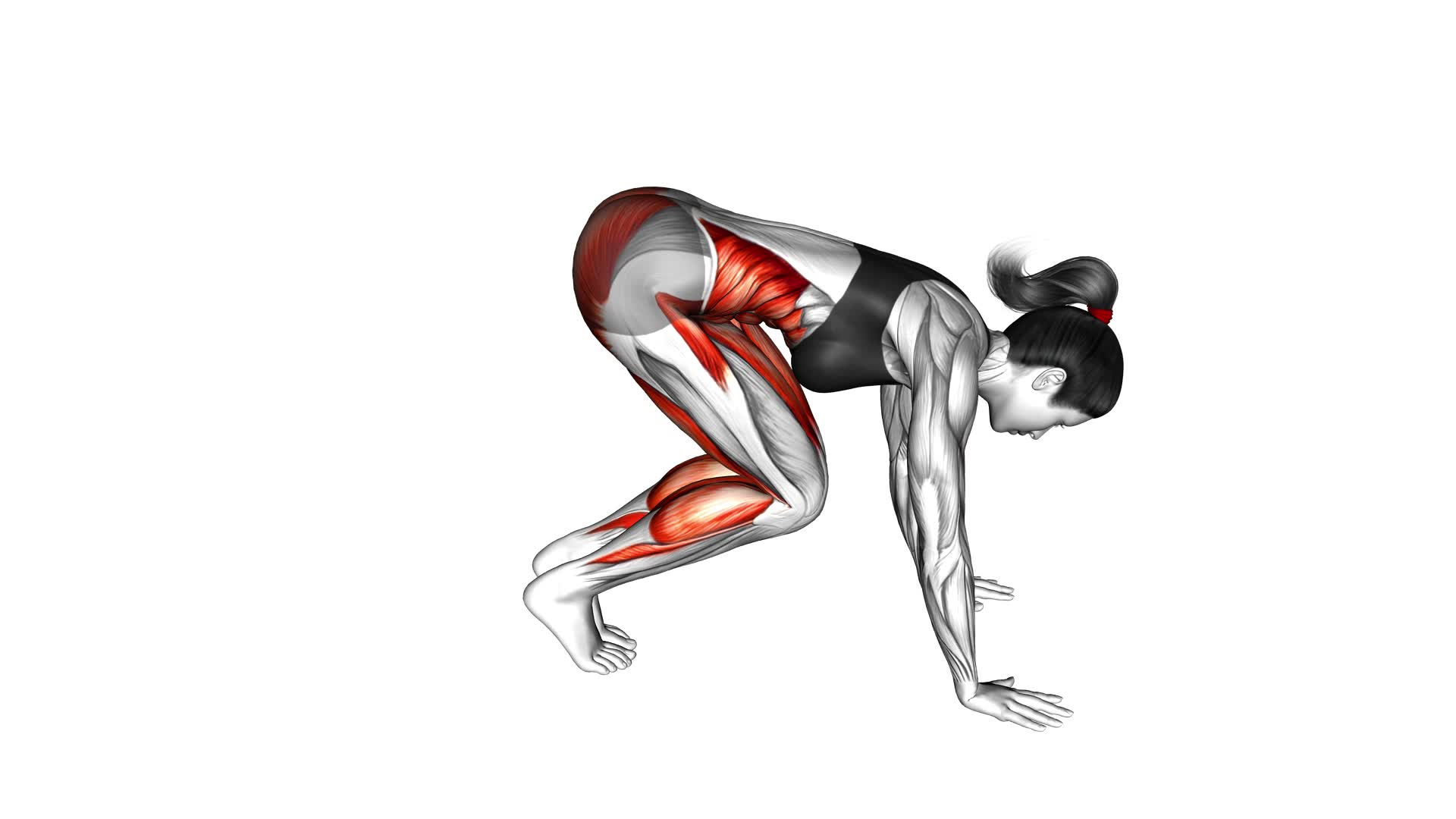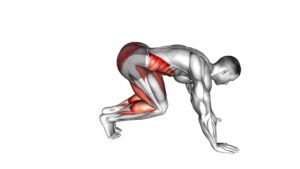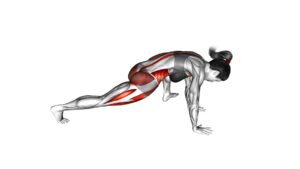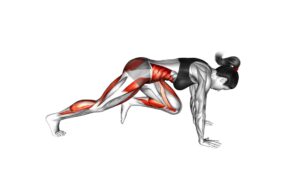Mountain Climber Walk (female) – Video Exercise Guide & Tips

Are you looking for an effective and challenging workout? Look no further than the Mountain Climber Walk!
Watch This Exercise Video
This video exercise guide and tips will show you the proper form and technique to get the most out of this exercise.
Whether you're a beginner or advanced, there are modifications and progressions for all fitness levels.
Get ready to sweat and strengthen your entire body with the Mountain Climber Walk.
Let's get started!
Key Takeaways
- Mountain climber walk targets multiple muscle groups.
- It boosts cardiovascular fitness and improves cardiovascular endurance.
- It strengthens core muscles.
- It provides incredible results.
Benefits of the Mountain Climber Walk
Get ready to experience the numerous benefits of the Mountain Climber Walk, a highly effective exercise that targets multiple muscle groups and boosts your cardiovascular fitness. This exercise is perfect for improving your cardiovascular endurance and strengthening your core muscles. By incorporating the Mountain Climber Walk into your regular workout routine, you'll see incredible results.
One of the main benefits of the Mountain Climber Walk is its ability to improve cardiovascular endurance. As you perform the exercise, your heart rate increases, forcing your cardiovascular system to work harder. This helps to improve your overall stamina and endurance, allowing you to perform other physical activities with greater ease.
In addition to improving cardiovascular fitness, the Mountain Climber Walk also strengthens your core muscles. As you engage in this exercise, you're required to stabilize your body and maintain proper form. This activates your abdominal muscles, lower back muscles, and obliques, leading to a stronger and more stable core.
Now that you understand the benefits of the Mountain Climber Walk, it's time to learn about the proper form and technique for the exercise. By mastering the correct form, you can maximize the effectiveness of the exercise and avoid any potential injuries. So, let's dive into the next section and explore the proper form and technique for the Mountain Climber Walk.
Proper Form and Technique for the Exercise
To perform the Mountain Climber Walk exercise correctly, start by getting into a plank position. Place your hands directly under your shoulders and extend your legs straight behind you, balancing on the balls of your feet. Keep your core engaged and your body in a straight line from head to heels.
From this position, begin by bringing your right knee towards your chest, then quickly switch and bring your left knee towards your chest, as if you're walking in place. Continue alternating legs in a fluid, controlled motion.
Maintain a steady pace throughout the exercise, keeping your hips level and avoiding any excessive upward or downward movement. Remember to breathe deeply and engage your abdominal muscles to maximize the effectiveness of the exercise.
For advanced modifications, you can try increasing the speed or intensity of the exercise. You can also add a push-up between each leg movement to further challenge your upper body and core strength.
By performing the Mountain Climber Walk exercise with proper form and technique, you'll be able to target your core, shoulders, and leg muscles effectively.
Now let's move on to the next section to learn about common mistakes to avoid and how to perform the exercise safely and efficiently.
Common Mistakes to Avoid
To avoid common mistakes while performing the Mountain Climber Walk exercise, focus on maintaining proper form and technique throughout the movement. By doing so, you can maximize your results and reduce the risk of injury.
One common mistake to avoid is letting your hips sag or rise too high during the exercise. This can put unnecessary strain on your lower back and decrease the effectiveness of the workout. Instead, aim to keep your body in a straight line from your head to your heels, engaging your core muscles to maintain stability.
Another mistake to watch out for is rushing through the exercise. Remember to move at a controlled pace, bringing your knees towards your chest one at a time while keeping your shoulders and arms stable. This will help you maintain proper form and ensure that you're targeting the right muscles.
Finally, it's important to avoid holding your breath while performing the Mountain Climber Walk. Instead, focus on breathing steadily and deeply throughout the movement to provide your muscles with enough oxygen and prevent fatigue.
Modifications and Progressions for All Fitness Levels
Now let's talk about how you can modify and progress the mountain climber walk to suit your fitness level.
If you're a beginner, there are modification options available to make the exercise more manageable for you.
On the other hand, if you're more advanced and looking for a challenge, there are progression techniques that can take your mountain climber walk to the next level.
Beginner Modification Options
Start with the modified version of the mountain climber walk to accommodate all fitness levels. This exercise is a great way to build strength, improve cardiovascular endurance, and engage your core muscles.
Here are some beginner modifications and variations for beginners:
- Slow down the pace: Take it slow and focus on maintaining proper form. This will help you build stability and control.
- Reduce range of motion: Instead of bringing your knees all the way to your chest, start by bringing them halfway. As you get stronger, increase the range of motion.
- Use a stability ball: Place your hands on a stability ball instead of the floor. This will provide extra support and make the exercise less challenging.
- Remember to breathe: Inhale as you bring your knees in and exhale as you extend your legs back.
Remember, everyone starts somewhere. Don't be discouraged if you need to modify the exercise initially. With time and practice, you'll be able to progress to the full mountain climber walk.
Keep pushing yourself and enjoy the journey!
Advanced Progression Techniques
Challenge yourself with advanced progression techniques to take your mountain climber walk to the next level. These progression variations and advanced modifications will push your limits and help you achieve even greater results.
One advanced modification you can try is the weighted mountain climber walk, where you add weight to your ankles or wrists to increase the intensity.
Another option is to elevate your feet on a step or bench, which will further engage your core and upper body.
Additionally, you can incorporate cross-body mountain climbers by bringing your knee towards the opposite elbow, challenging your coordination and stability.
Remember to always maintain proper form and listen to your body.
Now that you're familiar with advanced progression techniques, let's move on to the next section for tips on how to make your mountain climber walk workout more effective.
Tips for an Effective Mountain Climber Walk Workout
To maximize the effectiveness of your mountain climber walk workout, focus on maintaining proper form and engaging your core throughout the exercise. By following these tips, you can take your workout to the next level and achieve your fitness goals:
- Try different mountain climber variations: To challenge your body in new ways, incorporate variations into your mountain climber walk. Experiment with different tempos, such as slow and controlled or fast and explosive. You can also try adding a twist to target your obliques or elevating your feet to engage your shoulders and upper body.
- Incorporate advanced mountain climber exercises: Once you have mastered the basic mountain climber walk, it's time to level up. Introduce advanced exercises like the cross-body mountain climber, where you bring your knee towards the opposite elbow, or the spider mountain climber, where you bring your knee out to the side towards your elbow. These exercises will challenge your coordination and increase the intensity of your workout.
- Focus on your breathing: Proper breathing technique is crucial during any workout. As you perform the mountain climber walk, remember to breathe deeply and exhale forcefully with each knee drive. This will help you maintain your energy levels and maximize the efficiency of your workout.
Incorporating the Mountain Climber Walk Into Your Fitness Routine
To incorporate the mountain climber walk into your fitness routine, focus on incorporating it as a dynamic cardio and core strengthening exercise. The mountain climber walk is a versatile exercise that can be modified and varied to suit your fitness level and goals.
One way to incorporate the mountain climber walk is by adding it to your HIIT (High-Intensity Interval Training) workout. Begin with a warm-up, then perform a set of mountain climber walks for 30 seconds, followed by a 10-second rest. Repeat this interval for a total of 5-10 rounds. This won't only improve your cardiovascular endurance but also help you burn calories and shed excess weight.
Another variation of the mountain climber walk is to incorporate it into a circuit training routine. Combine it with other bodyweight exercises like push-ups, squats, and lunges to create a full-body workout. This will engage multiple muscle groups and increase your overall strength and endurance.
If weight loss is your goal, consider incorporating the mountain climber walk into a comprehensive weight loss program. Combine it with a balanced diet and regular strength training exercises to maximize calorie burn and promote fat loss.
Incorporating the mountain climber walk into your fitness routine can add a challenging and effective element to your workouts. Remember to listen to your body, start slowly, and gradually increase the intensity and duration of your workouts. Stay consistent, stay motivated, and enjoy the benefits of this dynamic exercise.
Frequently Asked Questions
How Many Calories Does the Mountain Climber Walk Burn?
The mountain climber walk is a great exercise for calorie burning benefits. By engaging multiple muscle groups, this exercise can help you burn a significant number of calories.
To maximize the calorie burning potential, it's important to maintain proper form. Keep your core engaged, shoulders over your hands, and alternate bringing your knees toward your chest.
With consistent effort, you'll see the results you want while enjoying the benefits of this challenging exercise.
Can the Mountain Climber Walk Help With Weight Loss?
The mountain climber walk is a great exercise for weight loss. It not only burns calories but also improves cardiovascular health. By engaging multiple muscle groups and increasing your heart rate, it helps you shed those extra pounds.
If you're a beginner, there are variations of the mountain climber walk that you can try. Start with slow and controlled movements, and gradually increase your speed and intensity as you get more comfortable.
Keep pushing yourself, and you'll see the results you desire.
Is It Necessary to Wear Specific Footwear for the Mountain Climber Walk?
When doing the mountain climber walk, it's important to wear appropriate footwear. Whether you're doing it indoors or outdoors, the right shoes can make a big difference. They provide support and stability, reducing the risk of injuries.
Outdoor training requires shoes with good grip to handle different terrains. Wearing the right footwear also enhances your performance and comfort during the exercise.
Can the Mountain Climber Walk Be Done Outdoors?
Yes, the mountain climber walk can definitely be done outdoors. Taking your workout outside can provide added benefits like fresh air and vitamin D from the sun.
Plus, you have more space to explore different variations of the mountain climber walk, such as uphill climbs or incorporating obstacles like rocks or tree stumps.
Are There Any Age Restrictions for Performing the Mountain Climber Walk?
When it comes to the mountain climber walk, you might be wondering if there are any age restrictions.
Well, the great news is that there are no specific age limits for performing this exercise. However, it's important to keep safety precautions in mind. Make sure to listen to your body, start slow, and gradually increase intensity.
Always consult with a healthcare professional if you have any concerns or underlying health conditions.
Conclusion
Incorporating the mountain climber walk into your fitness routine can provide numerous benefits. This exercise is known for improving cardiovascular endurance, core strength, and overall body conditioning. By maintaining proper form and technique, individuals of all fitness levels can enjoy a challenging and effective workout.
To make the most out of the mountain climber walk, it's important to avoid common mistakes. One common mistake is rushing through the exercise, sacrificing form for speed. It's crucial to maintain a stable and controlled position throughout the movement. Another mistake is not engaging the core muscles properly. To maximize the benefits, focus on keeping the core tight and engaged.
Modifications can be made to accommodate different fitness levels and goals. For beginners, starting with slower and controlled movements can help build strength and stability. Advanced individuals can add variations such as mountain climbers with a twist or performing the exercise on an unstable surface like a Bosu ball.
So lace up your sneakers, step up to the challenge, and conquer the mountain climber walk for a fitter and healthier you. With dedication and consistency, you can continue pushing yourself and never stop climbing towards your fitness goals.

Author
Years ago, the spark of my life’s passion ignited in my mind the moment I stepped into the local gym for the first time. The inaugural bead of perspiration, the initial endeavor, the very first surge of endorphins, and a sense of pride that washed over me post-workout marked the beginning of my deep-seated interest in strength sports, fitness, and sports nutrition. This very curiosity blossomed rapidly into a profound fascination, propelling me to earn a Master’s degree in Physical Education from the Academy of Physical Education in Krakow, followed by a Sports Manager diploma from the Jagiellonian University. My journey of growth led me to gain more specialized qualifications, such as being a certified personal trainer with a focus on sports dietetics, a lifeguard, and an instructor for wellness and corrective gymnastics. Theoretical knowledge paired seamlessly with practical experience, reinforcing my belief that the transformation of individuals under my guidance was also a reflection of my personal growth. This belief holds true even today. Each day, I strive to push the boundaries and explore new realms. These realms gently elevate me to greater heights. The unique combination of passion for my field and the continuous quest for growth fuels my drive to break new ground.







